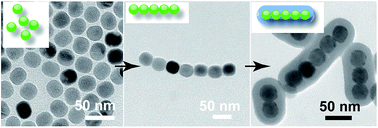Chainlike assembly of oleic acid-capped NaYF4:Yb,Er nanoparticles and their fixing by silica encapsulation†
Abstract
We demonstrate, through simply tuning the polarity of the dispersant system, that oleic acid (OA)-capped NaYF4 nanoparticles can be self-assembled into chainlike structures. The assembled chainlike structures were further fixed by silica encapsulation via the Stöber method. The reported approach can be readily extended to other OA-capped nanoparticles in organic solvents.


 Please wait while we load your content...
Please wait while we load your content...